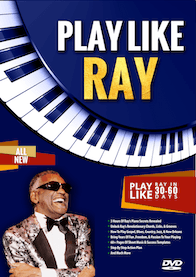Barrelhouse Piano – 5 Easy Moves To Get Started
 Would you like to learn some easy Barrelhouse Piano techniques?
Would you like to learn some easy Barrelhouse Piano techniques?
You’re in the right place.
In this lesson, we’re going to look at some Barrelhouse Piano moves from Little Brother Montgomery.
Let’s get started.
Barrelhouse Piano Demonstration By Little Brother Montgomery
To kick things off, take 4 minutes to watch Little Brother Montgomery with his Barrelhouse Piano classic “Vicksburg Blues”:
1. How To Play A Barrelhouse Piano Left-Hand Comping Pattern
 Little Brother Montgomery uses a distinct “rolling” left-hand technique.
Little Brother Montgomery uses a distinct “rolling” left-hand technique.
It’s actually a really fast, slurred chromatic pass from the 6th of the chord to the root.
Little Brother Montgomery plays this roll on the 1st beat. He then plays a power chord (root 5th) followed by a 6th then back to a power chord.
The left hand figure over one bar then looks like this when notated:

Check out the fingering: In this case the 3rd finger on the Ab simply slides down and lands on the A natural.
Practice this left hand pattern in all 12 keys to get used to the feel of it.
In many aspects, this rolling left-hand pattern allows you to emulate a train running along the tracks.
Let’s look at another technique that Little Brother Montgomery is fond of.
2. How To Comp Barrelhouse Style While Singing
 To accompany his singing, Little Brother Montgomery uses left-hand chromatic rolls to embellish the chord tones in a 4-bar walkup.
To accompany his singing, Little Brother Montgomery uses left-hand chromatic rolls to embellish the chord tones in a 4-bar walkup.
In addition to that, he plays some block chords with the right hand.
Check out the sheet music for this comping pattern:

This is how his comping style over his voice sounds like this:
 Speaking of learning how to comp for singers, the best person to study is Ray Charles.
Speaking of learning how to comp for singers, the best person to study is Ray Charles.
Ray is famous for singing while playing some really interesting piano parts in various styles.
Discover how to do this by learning how to Play Like Ray.
Inside Play Like Ray, you’ll learn a step-by-step exploration of hundreds of ray’s licks, chords, songs, solos, & grooves that can be used on thousands of different songs.
Get instant access to Play Like Ray here.
Now, check out what you can do to fill in the spaces in between vocal lines.
3. How To Respond To Vocal Lines The Barrelhouse Way
 Call and response is a staple of blues piano.
Call and response is a staple of blues piano.
To make things interesting, you need to learn how to respond in a catchy way to musical ideas.
A great way to do that is by using a classic Barrelhouse Piano lick.
Here’s an example:
This lick from Little Brother Montgomery starts with his trademark rolling towards the root note of the chord.
This is followed by playing the root note repetitively followed by a nice descending line back to the tonic chord:

4. How Little Brother Montgomery Adds Some “Modern” Flavor
The next lick Barrelhouse Piano lick from Little Brother Montgomery incorporates a tone cluster based on the F minor blues scale:
In the example above, Little Brother Montgomery plays Bb-C-Eb-F, all of which are notes in the F blues scale.
He follows this up with a small lick.
Here’s the transcription of this particular passage:

 Speaking of more blues licks and chords, the Breakthrough Blues Method offers plenty.
Speaking of more blues licks and chords, the Breakthrough Blues Method offers plenty.
Inside the Breakthrough Blues Method, you’ll discover detailed notation of hundreds of amazing blues piano licks and chords.
Here’s where you can level up with the Breakthrough Blues Method.
Want more ways of expanding your vocabulary? Discover more below:
5. One Secret Barrelhouse Piano Lick Generator
In one point during his piano improv, Little Brother Montgomery plays this lick:

The key that you can get out this lick is the note choice and the pattern.
This is the Barrelhouse Piano lick generator at its bare essence:

This lick bears similarity to Clifford Brown’s technique of playing notes a half step up or down just before the chord tone.
There are three ways of looking at this lick:
- It is the chord tones of an F7 chord with leading tones approaching the b7, the 5th, and the 3rd.
- An F6 arpeggio with a note a half step above the 6th and leading tones toward the 5th and the 3rd.
By learning this lick in all 12 keys, you can start learning how to play things such as:
- Enclosure patterns
- Cool descending runs
Lastly, it’s easy to remember how to play licks based off of this because you only have to remember the chord tones.
But is something like our Barrelhouse Piano lick generator enough to get you through a gig?
The Number One Reason You’ve Hit A Wall (And What To Do About It)
 Let’s face it: You’ve been all over the place on the web because you’ve hit a wall in your playing.
Let’s face it: You’ve been all over the place on the web because you’ve hit a wall in your playing.
It’s not pleasant at all, I know.
Just like every serious student, you’ve tried out every video lesson on YouTube.
However, you find yourself lacking the necessary skills to go the next level.
This is because your foundation isn’t there yet.
Don’t lose hope. I have some good news for you.
We can build that solid foundation for jazz and blues piano inside the Jazz Inner Circle.
 Your Jazz Inner Circle mentors have toured the world and worked with award-winning artists. They certainly know what you need to succeed in the studio and on the stage.
Your Jazz Inner Circle mentors have toured the world and worked with award-winning artists. They certainly know what you need to succeed in the studio and on the stage.
Inside the Jazz Inner Circle, you’ll discover:
- Private 1:1 lessons with a world-class jazz piano instructor.
- “The Jazz Piano Mastery Program” (Over $25,000 worth of jazz piano training resources, tools, practice templates, improv strategies, & tons more.)
- Access to over 50 hours of high-level jazz intensive workshops.
Get one-on-one jazz piano training here.
I hope that you enjoyed this Barrelhouse Piano lesson. If you have any questions, comments, or suggestions for new lessons, feel free to leave a comment below?
All right. Time for you to try out the concepts yourself.
